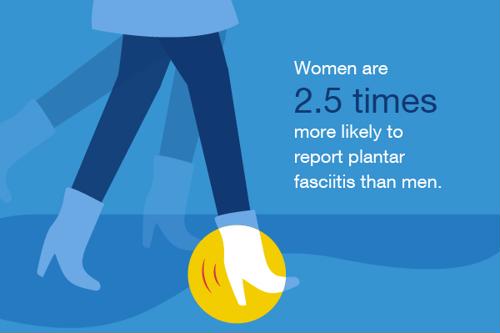
According to Medscape, plantar fasciitis is defined as a type of foot pain caused by degenerative inflammation and soreness of the plantar fascia, or the thick sole tissue that connects your heel bone to your toes.
This condition is most commonly caused by strain injury, which results in ligament tears and can lead to heel and foot pain, stiffness and tenderness. Strain injuries often occur due to too much walking or running, wearing the wrong type of footwear or jumping and landing poorly. If you're living with plantar fasciitis, you may find it more difficult to go about normal everyday activities, as pain can range from mild to debilitating.
Here are a few alarming statistics about plantar fasciitis you should know:
8 surprising statistics about plantar fasciitis
1. According to Foot.com, 75% of the U.S. population will live with some type of foot problem during their lifetime.
2. Nearly 10% of the population will experience plantar fasciitis at some point.
3. More than 2 million individuals seek treatment for plantar fasciitis on an annual basis.
4. Research by the National Center for Complementary and Integrative Health found that overall diagnosed plantar fasciitis cases with pain amounted to 0.85% of U.S. adults in 2013.
5. Prevalence of diagnosed plantar fasciitis was highest in individuals aged between 45 and 65.
6. Women are 2.5 times more likely to report plantar fasciitis than men. This is likely because the average female walks three more miles per day than men.
7. Those diagnosed with the condition are twice as likely to seek relief from prescription medication.
8. About 20% of the nation's population has high arches, which are major contributors to experiencing plantar fasciitis.
Tips for dealing with plantar fasciitis pain
If you're currently living with plantar fasciitis or believe the condition may impact you in the future, it's wise to devise a plan for pain management. Consider one – or all – of the following coping mechanisms.
Stretches that focus on the soles of your feet can help alleviate issues. Washington University Physicians recommended grabbing your toes with one hand to stretch your arches, calf muscles and soles. Hold this move for 10 seconds and repeat on each foot two times.
Massaging the arch of the foot is also essential. Roll a frozen water bottle or therapy ball back and forth to relieve tension and mitigate pain in the fascia. Practice this a few times a week for relief.
Arch support in your shoes may also be the solution for the pain. Softstride Orthotics by Brownmed can address specific pain in the heels, ankles, arches or legs. Browse through the forefoot and hindfoot inserts, insoles and underliners today.
You may need more support than arch soles alone can provide. The Nice Stretch Plantar Fasciitis Sleeve from Brownmed is designed with X-Stretch technology to properly distribute pressure throughout the foot to ensure balanced compression and support throughout the ankle, arch and heel.
For more information on Softstride and Nice Stretch products, browse the Brownmed database today.
